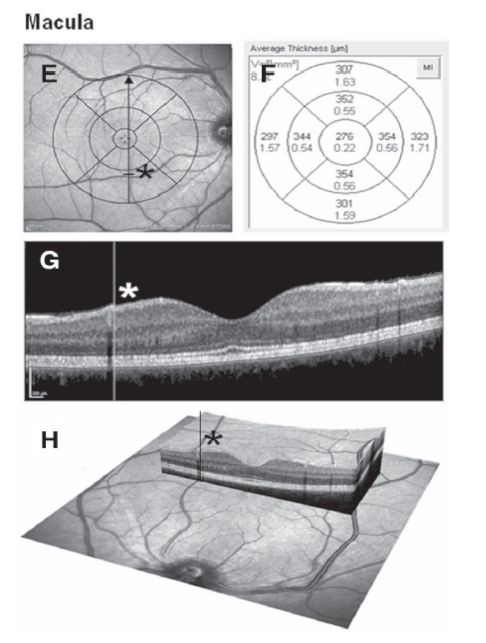Hydroxychloroquine Retinopathy among Rheumatoid Patients on Hydroxychloroquine (HCQ) Therapy in Malaysia
Main Article Content
Abstract
Objective: To determine the correlation between age, duration and accumulative dose of Hydroxychloroquine (HCQ) usage in HCQ retinopathy.
Methods: This cross-sectional study recruited 130 rheumatoid patients on HCQ therapy. The macula thickness and volume were measured by Spectra-Domain Optical Coherence Tomography (SD-OCT), while visual field examination was performed using Humphrey visual field 24-2 (HVF).
Results: The incidence of HCQ retinopathy observed in rheumatology patients in this study was 1.54% (2 out of 130 patients). No significant difference was noted between mean age of HCQ retinopathy patients (50.5 ± 3.53 years) compared to non-retinopathy patients (42 ± 14 years, P = .39). Similarly, no significant median duration of HCQ intake was observed between retinopathy patients (5475 days, IQR = 0) and non-retinopathy patients (2190 days, IQR = 2555, P = .11). The median daily dose of HCQ did not reveal a significant difference between retinopathy patients (250 mg/d, IQR = 0) and non-retinopathy patients (200 mg/d, IQR = 0, P = .11). Likewise, no significant difference exist in the median accumulative dose of HCQ retinopathy patients (1460 g, IQR = 0), compared to non-retinopathy patients (474.5 g, IQR = 450, P = .1). Overall, the association factor between age, duration and cumulative dose to HCQ retinopathy were not significant (P > .05). However, the average macular thickness and macular volume were significantly lesser in inner macula among retinopathy patients (P < .05).
Conclusion: This study showed no statistically significant relationship was noted between age, duration of HCQ intake, cumulative and the daily dose of HCQ to retinopathy
Article Details

This work is licensed under a Creative Commons Attribution-NonCommercial-NoDerivatives 4.0 International License.
References
Dorner T. Therapy: hydroxychloroquine in SLE: old drug, new perspectives. Nat Rev Rheumatol 2010;6:10-1.
Cansu DU, Korkmaz C. Hypoglycaemia induced by hydroxychloroquine in a non-diabetic patient treated for RA. Rheumatology (Oxford) 2008;47:378-9.
Alarcon GS, McGwin G, Bertoli AM, Fessler BJ, Calvo-Alen J, Bastian HM, et al. Effect of hydroxychloroquine on the survival of patients with systemic lupus erythematosus: data from LUMINA, a multiethnic US cohort (LUMINA L). Annals of the rheumatic diseases 2007;66(9):1168-72.
Smolen JS, Landewe R, Bijlsma J, Burmester G, Chatzidionysiou K, Dougados M, et al. EULAR recommendations for the management of rheumatoid arthritis with synthetic and biological disease modifying antirheumatic drugs: 2016 update. 2017;76(6):960-77.
Tett SE, Cutler DJ, Day RO, Brown KF. Bioavailability of hydroxychloroquine tablets in healthy volunteers. Br J Clin Pharmacol 1989;27:711-79.
Rosenthal AR, Kolb H, Bergsma D, Huxsoll D, Hopkins JL. Chloroquine retinopathy in the rhesus monkey. Invest Ophthalmol Vis Sci 1978;17:1158-75.
Sundelin SP, Terman A. Different elements of chloroquine and hydroxychloroquine on lysosomal function in cultured retinal pigment epithelial cells. APMIS 2002;100:481-9.
Hui Jen Ding, Alastair K Denniston, Vijay K. Rao, Caroline Gordon. Hydroxychloroquine related retinopathy. PMID: 26428520, DOI: 10.1093/rheumatology/kev357.
Bernstein HN . Ophthalmologic considerations and testing in patients receiving long-term antimalarial therapy. Am J Med 1983;75:25-34.
Yam JC, Kwok AK. Ocular toxicity of hydroxychloroquine. Hong Kong Med J 2006;12:294-304.
Rodriguez-Padilla JA, Hedges TR III, Monson B et al. High-speed ultra-high-resolution optical coherence tomography findings in hydroxychloroquine retinopathy. Arch Ophthalmol 2007;125:775-80.
Stepien KE, Han DP, Schell J et al. Spectral-domain optical coherence tomography and adaptive optics may detect hydroxychloroquine retinal toxicity before symptomatic vision loss. Trans Am Ophthalmol Soc 2009;107:28-33.
Chen E, Brown DM, Benz MS et al. Spectral domain optical coherence tomography as an effective screening test for hydroxychloroquine retinopathy (the flying saucer sign). Clin Ophthalmol 2010;4:1151-8.
Puneet argawal. Early effect of hydroxychloroquine therapy: relationship between cumulative dose and retinal thickness. July 2014. Cutaneous and Ocular Toxicology 34(3). DOI:10.3109/15569527. 2014.938751.
Nuanpan Tangtavorn et al. Incidence of and risk factor for chloroquine and hydroxy-chloroquine retinopathy in Thai rheumatologic patients 2016. Clin Ophthalmol. 2016;10:2179-85.
Doo-ri Eo, Min Gyu Lee; Frequency and clinical characteristics of hydroxychloroquine retinopathy in Korean patients with rheumatologic diseases. J Korean Med Sci 2017;32(3):522-7.
AAO Quality of Care Secretariat, Hoskins Center for Quality Eye Care Recommendations on screening for chloroquine (CQ) and hydroxychloroquine (HCQ) retinopathy-2016. https://www.aao.org/clinical-statement/revised-recommendations-on-screening-chloroquine-h.
RCOphth guideline: Hydroxychloroquine and Chloroquine Retinopathy: new screening recommendations February 2018. https://www.rcophth.ac.uk/wp-content/uploads/2020/02/HCRRecommendations-on-Monitoring.pdf.
Marmor MF, Kellner U, Lai TY, LyonsJS, Mieler WF; American Academy of Ophthalmology. Revised recommendations on screening for chloroquine and hydroxychloroquine retinopathy. Ophthalmology 2011;118:415-22.
Marmor MF, Kellner U, Lai TY, Melles RB, Mieler WF; American Academy of Ophthalmology. Recommendations on screening for chloroquine and hydroxychloroquine retinopathy (2016 revision). Ophthalmology 2016;123:1386-94.
Tsang AC, Ahmadi Pirshahid S, Virgili G, Gottlieb CC, Hamilton J, Coupland SG. Hydroxychloroquine and chloroquine retinopathy: a systematic review evaluating the multifocal electroretinogram as a screening test. Ophthalmology 2015;122(6):1239-51.e4.
Lee DH, Melles RB, Joe SG, Lee JY. Pericentral Hydroxychloroquine Retinopathy in Korean Patients. Epub 2015. doi:10.1016/j.ophtha.2015.01.014.
Shechtman D, Reynolds SA. How to identidy and screen medication caused retinal toxicity in 2016. https://www.optometricmanagement.com/issues/2016/september-2016/clinical-posterior
Melles RB, Marmor MF. The risk of toxic retinopathy in patients on long-term hydroxychloroquine therapy. JAMA Ophthalmol 2014;132:1453-60.
Silman A, Shipley M. Ophthalmological monitoring for hydroxychloroquine toxicity: a scientific review of available data. Br J Rheumatol 1997;36:599-601.
Tehrani R, Ostrowski RA, Hariman R, Jay WM. Ocular toxicity of hydroxychloroquine. Semin Ophthalmol 2008;23:201-9.
Wolfe F, Marmor MF. Rates and predictors of hydroxychloroquine retinal toxicity in patients with rheumatoid arthritis and systemic lupus erythematosus. Arthritis Care Res (Hoboken) 2010;62(6):775-84.
Pharmacokinetics and Bioequivalence Study of Hydroxychloroquine Sulfate Tablets in Chinese Healthy Volunteers by LC–MS/MS. Rheumatol Ther 2015;2(2):183-95.
Lee DH, Melles RB, Joe SG, Lee JY, Kim JG, Lee CK, et al. Pericentral hydroxychloroquine retinopathy in Korean patients. Ophthalmology 2015;122:1252-6.
Early Treatment Diabetic Retinopathy Study Research Group. ETDRS Report No. 7: Early Treatment Diabetic Retinopathy Study design and baseline patientcharacteristics. Ophthalmology 1991;98:741-56.


